OctoPrint is arguably the most widely used wireless 3D printer host. This isn’t surprising considering the extent of its functionality and ease of use.
OctoPrint is paired with a Raspberry Pi, and together, they provide a simple solution for remotely accessing your 3D printer. You can send files, slice models, and monitor your prints in a variety of ways.
While many hobbyists are satisfied with OctoPrint’s capabilities, some may be looking for more control, the ability to connect to more printers, or simply a different approach. In search of some diversity, we’ll be diving into several OctoPrint alternatives, discussing why they may be worthy of your printer. Before we do that, however, let’s go over some important factors to keep in mind while hunting for alternatives.
Considerations

For our list, we were essentially looking for software that possesses the same fundamental features as OctoPrint:
- Remote access: An OctoPrint alternative must provide some level of wireless monitoring and control.
- Ease of setup and use: The software must be relatively easy to set up and use. This includes any extra hardware configuration.
- Control: The software must provide features that take advantage of wireless control and improve workflow.
So, now that we know what we’re looking for, let’s check out the options! Note that we’ve listed them in alphabetical order.
3DPrinterOS
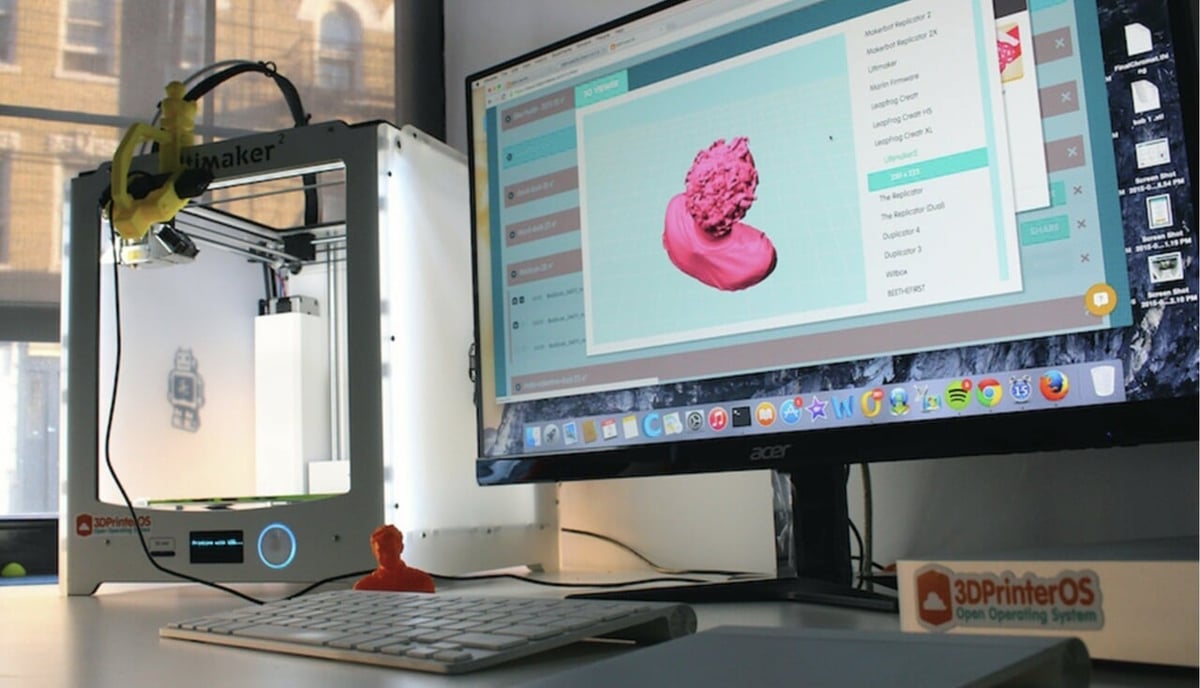
3DPrinterOS is a cloud-based service that manages to offer a huge number of features and excellent control without sacrificing ease of use.
The cloud features of 3DPrinterOS provide everything you need, including searching, repairing, and slicing a file. They’ve managed to keep it simple and intuitive for beginners, while also offering more advanced slicer settings for the detail-oriented.
The majority of the interface is part of their website, including slicing and analytics. This provides the flexibility to control and monitor from any device.
3DPrinterOS offers software for all operating systems and even a Raspberry Pi image. The setup for a Pi isn’t quite so simple, but they provide instructions for different options.
Many, but not all, of 3DPrinterOS’s features are free. It’s important to note that it’s geared towards large-scale operations, but there’s a limited trial version for free.
- Best for: Beginners to advanced users, including those with larger-scale operations
- Special features: Ability to monitor and control printing from any device, simple and intuitive interface
- Downsides: Complicated Pi setup
- Price: Limited free trial; pricing for organizations and educational institutions on request
AstroPrint
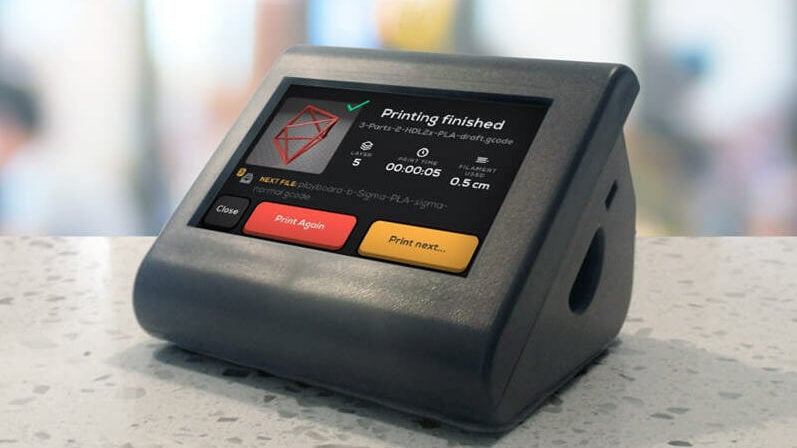
AstroPrint is a larger service built around the functionality of OctoPrint. It extends the idea of wireless control to an entirely cloud-based connection. To that end, AstroPrint allows you to save prints online and even import designs straight from 3D print sources such as MyMiniFactory. Additionally, they provide online Cura slicing, giving you the freedom to print from anywhere, including your phone, with their app.
With a friendly interface and mobile-enabled controls, AstroPrint shines in the usability department. They’ve focused on making everything as straightforward and simple as possible. Due to their novice-friendly design, however, AstroPrint leans towards limited controls instead of granular ones.
As for the setup, similar to OctoPrint, there’s a Raspberry Pi image that you can flash to get started. They also sell pre-flashed SD cards and pre-configured Raspberry Pi kits (called AstroBox), if you want to skip that part. AstroPrint is free for home users but can be upgraded for a monthly fee. They also offer plans for enterprise and university settings. Overall, AstroPrint is great for the novice looking for a wireless setup.
- Best for: Beginners as well as small or large businesses
- Special features: Entirely cloud-based, print from anywhere (including home), multiple printer control
- Downsides: Requires an AstroBox (for purchase) or a Raspberry Pi, less control compared to other solutions
- Price: Free for home users, ~$10 per month for more printers and file storage
BuildBee
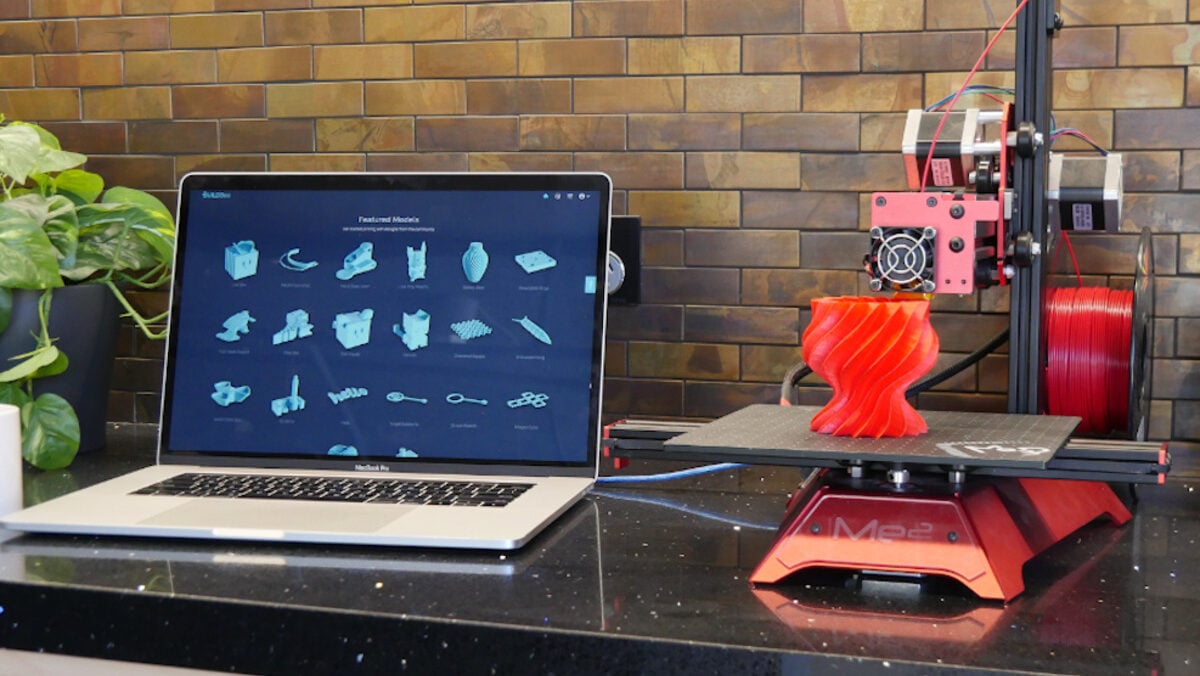
BuildBee is a cloud-based OctoPrint alternative that also offers a desktop app, as well as one for Android – iOS coming soon. It includes design and slicing capabilities as well as print monitoring.
In its design environment, BuildBee offers you the ability to create parametric designs. You can also import images to be rendered into 3D printable lithophanes and cookie cutters. But if you’d prefer to design your models in a different program, that’s not a problem! BuildBee integrates with a variety of 3D modeling packages, including Blender, Fusion 360, and Tinkercad.
BuildBee works with both SLA and DLP resin 3D printers as well as FDM printers. One of our favorite features is the ability to split large models automatically to fit on your build plate. You’ll need the Unlimited subscription to use their resin slicer software, however.
Much like OctoPrint, you can also monitor your printer. BuildBee can connect to a webcam to watch your printer remotely, which is particularly handy if you’re in a different room. With the Unlimited subscription, you can also control multiple printers and have options for multiple users. This is a great feature for educational institutions and makerspaces.
One of BuildBee’s most noteworthy features is BuildSense, a proprietary machine learning AI that gives you a “Printability” score for your model. This indicates how likely your model is to succeed. A lower score indicates your print will likely fail. BuildSense works by comparing your model to hundreds of thousands of similar prints that have been printed through BuildBee before. The model then analyses how similar your model is to models that have failed or succeeded. The AI doesn’t yet provide recommendations on how to fix your model. However, BuildBee provides a guide for you to use.
- Best for: Power users with multiple printers
- Special features: Built-in AI for checking model printability
- Downsides: Significantly limited Basic version compared to the Unlimited version
- Price: Free for Basic, ~$6 per month for Unlimited
Creality Wi-Fi Box 2.0

The Creality Wi-Fi Box 2.0 is a low-cost, plug-and-play alternative to OctoPrint that bundles hardware and software into one convenient platform. For around $40, the Creality Box 2.0 brings built-in Wi-Fi and webcam support to almost any Creality 3D printer.
And, unlike previous versions of the product, the 2.0 works on a handful of third-party 3D printers, as long as they’re running compatible Marlin firmware. According to some users, the 2.0 also supports third-party cameras, such as the Wyze Cam V2.
Using the Creality Wi-Fi Box 2.0 requires a user account for the Creality Cloud and a smartphone with the Creality Cloud app installed. This is handy if you want to print while outside of your home network. However, it does come with a privacy tradeoff, since any model you print will be sliced on Creality’s servers.
Additionally, some users have reported challenges when setting up the Creality Wi-Fi Box with certain printers, especially those with upgraded motherboards running aftermarket firmware. We recommend checking online to see if your specific printer (and any upgrades) is compatible with the Creality Wi-Fi Box 2.0 before purchasing one.
- Best for: Users with stock Creality mainboards and a tight budget
- Special features: Ability to start a print outside of your home’s Wi-Fi network
- Downsides: Limited compatibility for aftermarket upgrades, setup issues, potential privacy issues
- Price: ~$40
Duet Web Control
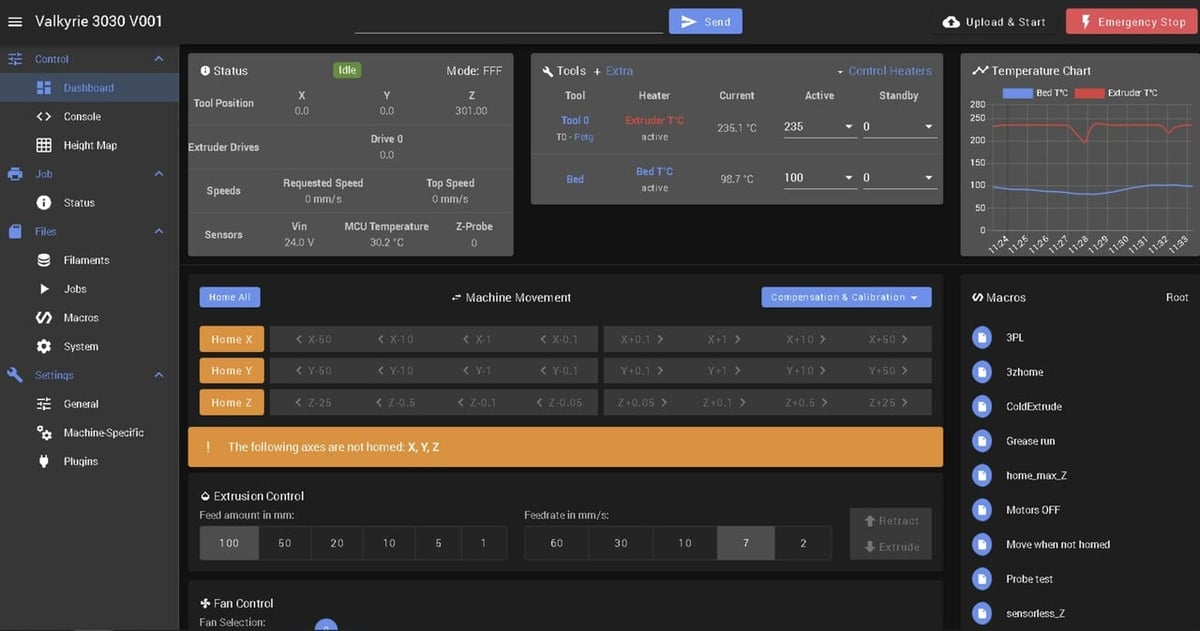
Duet Web Control is a software front-end created by the company Duet3D, primarily for Duet3D printer motherboards. Although few printers ship with a Duet3D motherboard, it’s a common option for custom 3D printer builds.
Plus, you can also use Duet Web Control with non-Duet motherboards, such as the BigTreeTech Octo Pro. Just make sure you’re running a compatible firmware package, like RepRap firmware 3.4.6.
A distinct feature of Duet Web Control is that it allows you to write and execute “G-code macros” so that you can quickly perform repetitive tasks such as printer tuning, bed leveling, filament changing, and more. This can be really handy for those in professional settings who want to be as efficient with their time as possible.
Furthermore, Duet Web Control allows users to create batch jobs by organizing and queueing up G-code files. This comes with a caveat, however, which is that you need to slice your models (whether in a batch or stand-alone) prior to uploading them to the web interface for printing.
- Best for: Users looking to build a DIY printer
- Special features: Batch jobs, macro scripts
- Downsides: Limited compatibility with 3D printer motherboards
- Price: Cost of a Duet3D mainboard
Klipper
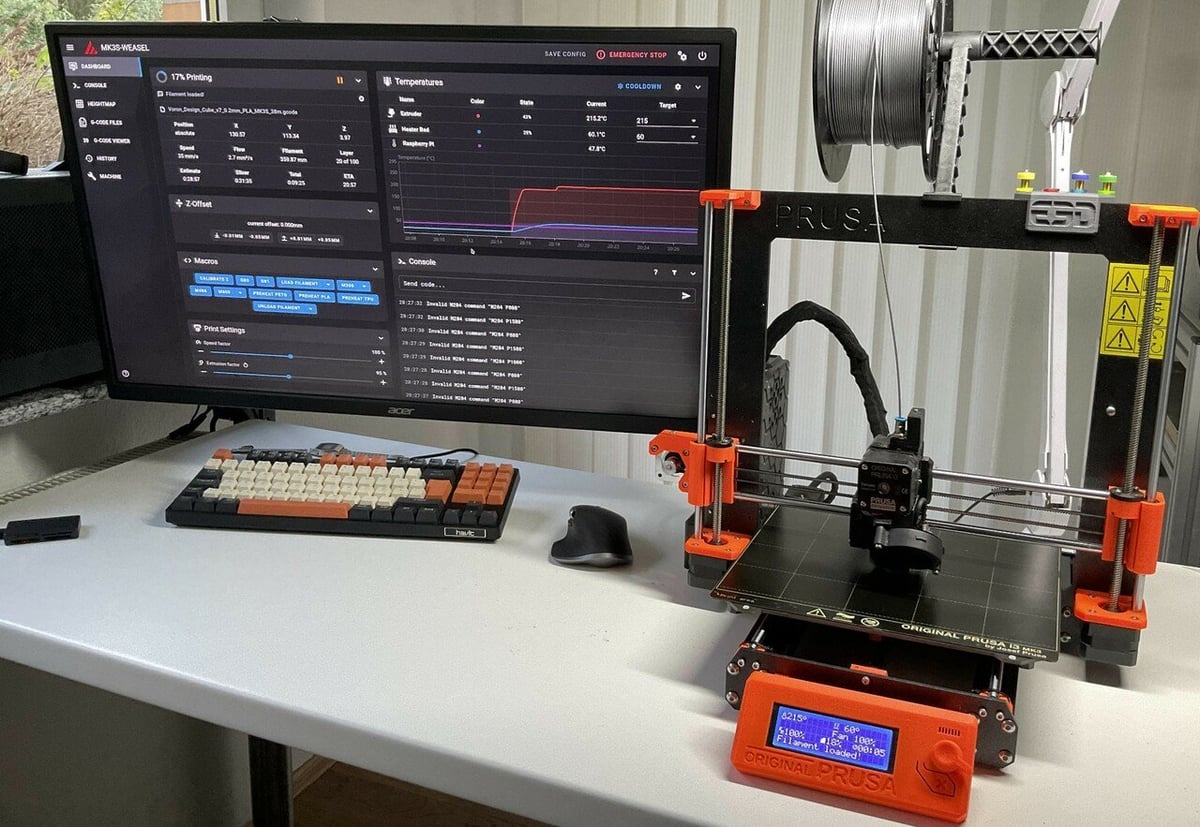
Unless you’ve been living under a 3D printed rock, you’ve probably heard of Klipper, the firmware that’s known for speeding up 3D printers. Unlike Marlin and other firmware packages, Klipper uses an external computer (e.g. Pi board) to process G-code commands faster. It allows for remote printer control and has a number of other great features.
There are a handful of terrific Klipper-based remote printer management platforms, most notably Mainsail and Fluidd. These two web-based platforms have modern, well-designed interfaces, loaded with innovative control features, such as real-time configuration file adjustments, webcam monitoring, temperature graphs, and more. And, like many of the other options on this list, Mainsail and Fluidd are both capable of cross-network communication.
Another option for Klipper 3D printers is the Creality Sonic Pad. The Sonic Pad is similar to the Creality Wi-Fi Box 2.0, but a whole lot more powerful (as well as costly). The device includes a large touchscreen display to replace your 3D printer’s LCD interface and is equipped with many of the same features as Klipper and Mainsail.
- Best for: Users running Klipper firmware
- Special features: Cross-network printer management, configuration file adjustment, input shaping, pressure advance, modern interface
- Downsides: Only works with Klipper 3D printers
- Price: $0-$160
MatterControl

MatterControl is free and open-source software by MatterHackers. It’s meant to be everything you need to make your own 3D prints. Unlike others on this list, this solution isn’t for large-scale operations. Instead, it’s a suite for your average hobbyist.
The software package includes everything from designing and slicing your 3D print to printing and monitoring it. The design suite is by no means complete CAD software; it’s best used for quick edits to existing print models. Additionally, the slicer provides an adequate amount of configuration potential for multiple printers and varieties of filament.
As for connectivity, you can save files online and monitor prints through their Cloud Sync. Although it does also allow for remote printing, it isn’t well-suited for it. That said, this is more of an additional feature rather than a defining one.
MatterControl is designed to be run from your regular computer, so you shouldn’t need anything extra. There’s no Raspberry Pi image, but there’s a Linux install if you’re determined to run it that way. Overall, the MatterHackers team has made great software aimed at the solo hobbyist.
- Best for: Individuals and small-scale projects
- Special features: Great for quick edits, ability to monitor and save prints through Cloud Sync
- Downsides: Non-ideal remote printing
- Price: Free
NanoDLP
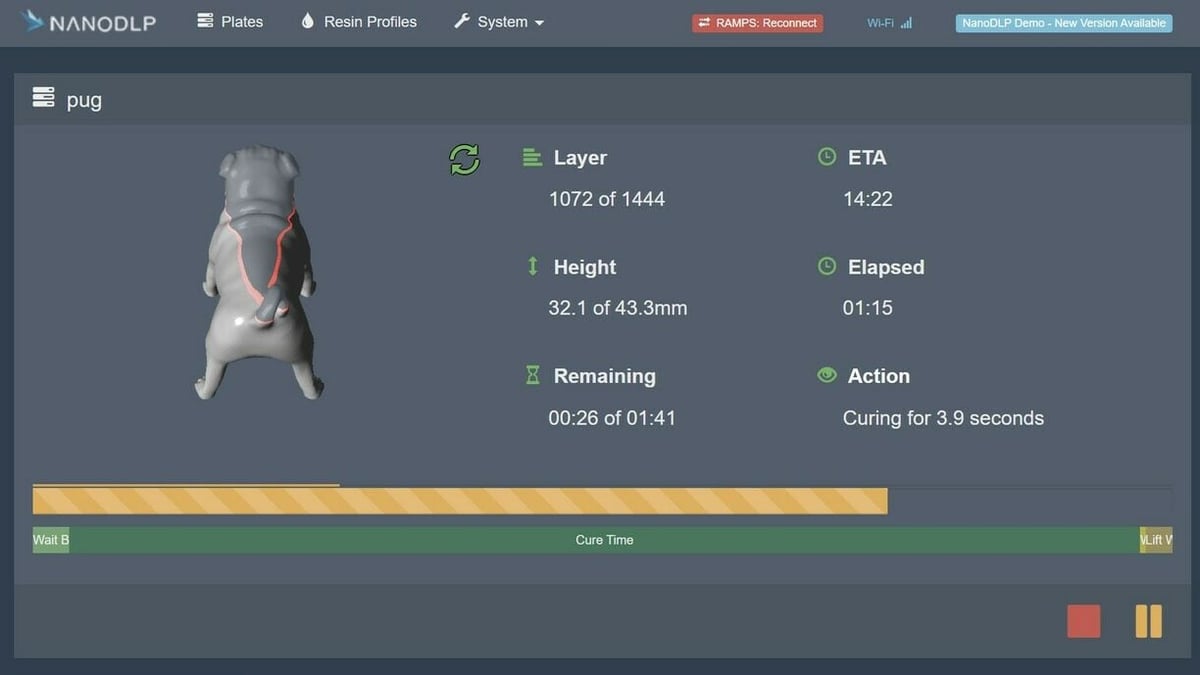
NanoDLP is made especially for the “lighter” side of printing. That is, SLS 3D printers as well as SLA and DLP resin 3D printers. It bundles many useful features into a neat 3D printing hosting package.
This continually improving software provides the functionality your light-based printer needs. It comes with setup configurations to accommodate any type of hardware, aw well as calibration options to dial it in. The printing process is detailed with an application log and plate preview. Most notably, there’s a support generator that allows you to create custom supports prior to printing.
NanoDLP has built its software around the Raspberry Pi. They’ve even gone so far as to support direct drive from the Pi via stepper drivers. Of course, this isn’t necessary, but it can be a unique DIY opportunity. For those who want to avoid using the Pi, it also supports Windows and Linux.
This software has all the features you need and can be set up wirelessly. And that’s not to mention the fact that NanoDLP is free.
- Best for: Beginners to advanced users
- Special features: Cloud control, compatible with a variety of hardware, great all-around software
- Downsides: Not for use with FDM printers
- Price: Free
Obico

Some of you may never have heard of Obico before, but we’d be willing to bet that you’ve heard of the Spaghetti Detective. Obico is the new name for the Spaghetti Detective, and it’s packed with all the same features you love and more!
The main attraction is its AI failure detection features that use machine learning to analyze the video of your print. The software will alert you to a likely failure so you can stop the print remotely and prevent filament wastage.
Obico is higher-level software than OctoPrint. To run effectively, you need to first install OctoPrint or Klipper to control your printer remotely. Obico then sits on top of one of these platforms and allows you to monitor your printer remotely through the Obico AI.
Like OctoPrint, Obico is an open-source community-maintained project, meaning that all of its source code is publicly accessible. Why does this matter? Obico is unique in that it offers either cloud-hosted or self-hosted options.
The cloud-hosted version is very simple to set up; it’s plug-and-play. However, the downside is that you’ll need to pay in order to take full advantage of Obico’s features. This is especially true if you have more than one printer. Whether that cost is offset by the reduction in filament you waste printing colorful spaghetti is a decision you’ll have to weigh.
Alternatively, self-hosting Obico is essentially free, provided you have an old computer to use. You won’t be able to set this up on a Raspberry Pi, as it’s just not powerful enough. Self-hosting is more complex to set up, and you’ll need to be familiar with Linux and Docker.
The pricing model for Obico’s cloud subscription is fairly complex. This is made up of paying for both the basic subscription plus $3 per printer. You also pay per hour of AI. Fortunately, the Obico pricing calculator can help you work out exactly how much you’d need to pay monthly.
- Best for: Peace of mind unattended printing
- Special features: AI detection of print failures
- Downsides: Cloud hosting option more expensive than the alternatives
- Price: Free for self-hosting, ~$4 per month for Pro with one printer included
Polar Cloud
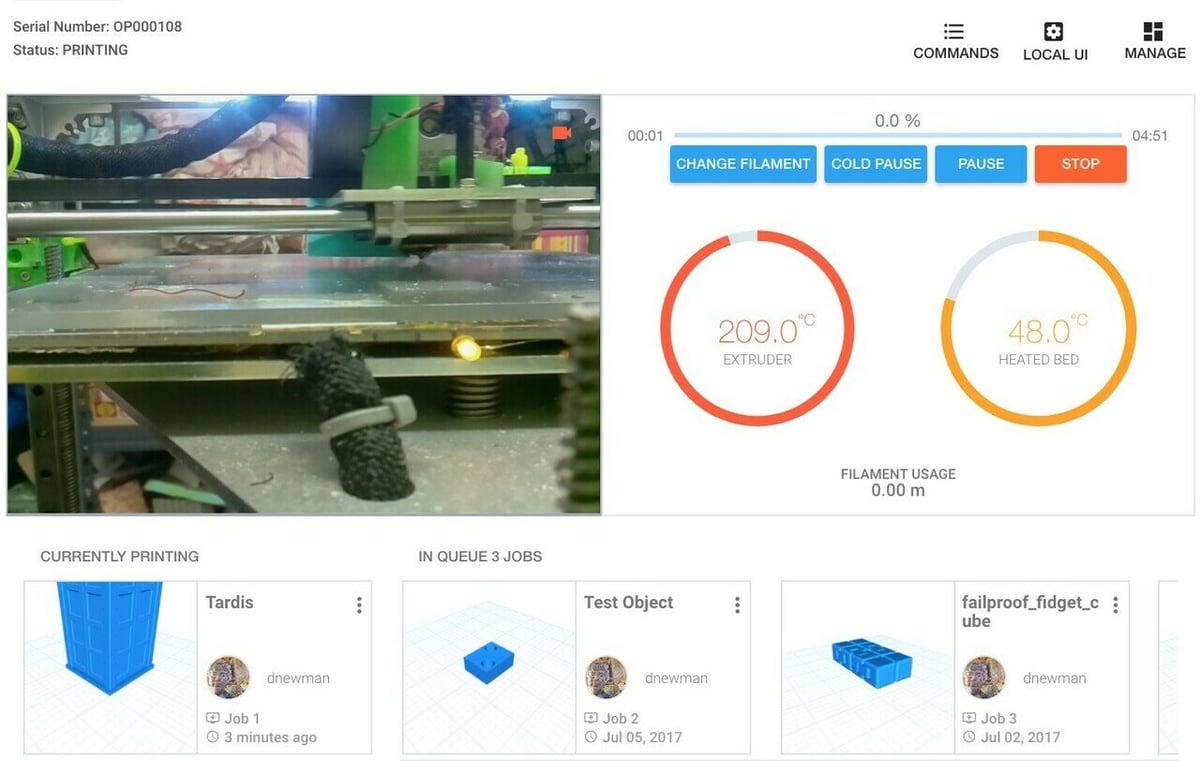
Polar Cloud is – you guessed it – a cloud-based 3D printer monitoring service and so much more. The interface is simple and clean, working to reduce jargon in favor of clear visual cues about what each setting does. The inclusion of design and slicing capabilities as well as print monitoring is fantastic.
The in-built slicer, Canvas, is feature rich and powerful. It provides multicolor support and can automatically re-slice your models to print on a different printer than the one you intended. You can even slice and print from your phone!
Polar Cloud has a lightweight web-based interface that’s able to control multiple printers, making it fantastic for makerspaces. This is also a great tool for education, as Polar Cloud supports Google Classroom integration and works with iPads and Chromebooks.
Overall, there’s a real community feel to the service. It enables you to avoid bottlenecks by requesting to use other people’s Polar-Cloud-connected 3D printers for your own jobs. Of course, this also works the other way as well: You can allow others to use your printer when you’re not using it.
And for those of you looking to make money from 3D printing, Polar Cloud has excellent features for entrepreneurs. For example, it allows you to sell your objects and receive tips.
- Best for: Browser-based multi-printer control
- Special features: Ability to outsource printing
- Downsides: Limited free features
- Price: Free, ~$5 per month for Premium
Printrun
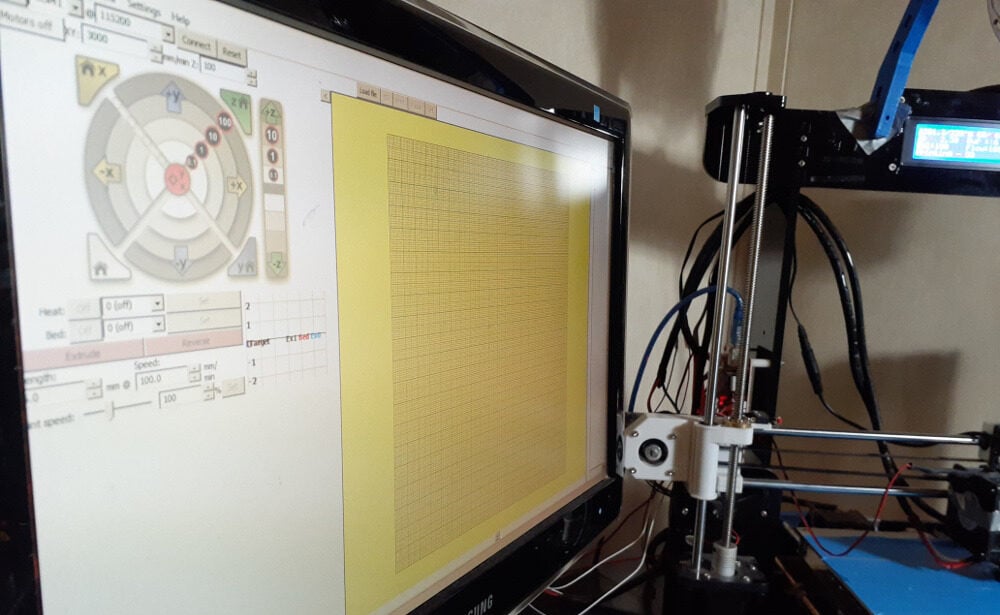
Printrun, by Kliment Yanev, is printing host software written in Python. It’s a printer controller and G-code sender with the potential for additional functionality.
Out of every option on the list, Printrun is the most customizable. The user interface is completely adjustable and even allows for custom buttons. Once you’re familiar with the software, you can create your own macros and write custom scripts.
With regard to connectivity, it doesn’t provide cloud services and doesn’t run a server by default. The key feature is its “hackability”, particularly its command-line interface. If this is to your taste, connecting via SSH to Printrun on a device such as a Pi should be a breeze.
Printrun may not be filled with the same features as the others on this list, but it carries the promise of open source much like OctoPrint. For example, there’s a web-monitoring project available on GitHub that makes use of Printrun to stream from a webcam. This program is the underdog with potential, but not for the novice DIYer.
- Best for: More experienced users
- Special features: Open-source project, extremely customizable
- Downsides: No cloud services
- Price: Free
PrusaLink

PrusaLink is one of Prusa Research’s latest projects and an excellent alternative to OctoPrint. Developed in-house, PrusaLink is a remote printer management platform that runs on your 3D printer’s local computer. Currently, PrusaLink is only compatible with Prusa 3D printers (e.g. Prusa i3 MK3S+), but the platform is still pretty new, so compatibility might be expanded in the future.
According to Prusa, PrusaLink’s primary purpose is to enable communication between your 3D printer and Prusa Connect. For reference, Prusa Connect is another Prusa platform that provides cloud services to enable truly remote 3D printer management and offers additional features for managing print farms.
While the two platforms sound similar, Prusa Connect is inherently cross-network and cloud based, while PrusaLink is run solely from the computer inside (or connected to) your 3D printer. Because of this, using PrusaLink alone only allows you to remotely control your 3D printer when connected to the same internet network.
Similar to OctoPrint, PrusaLink encompasses an online web interface for monitoring and controlling your 3D printer. As you can see above, the web interface is very sleek and provides visualizations of uploaded 3D models, temperature metrics, and more.
Plus, setting up PrusaLink on Prusa 3D printers is a very simple process, with the company providing detailed instructions on setting up your own PrusaLink server.
- Best for: Users with Prusa 3D printers and a tight budget
- Special features: Modern web interface, many control features, easy setup process
- Downsides: Limited printer compatibility, cross-network control only available with Prusa Connect
- Price: $0-$20
RaiseCloud
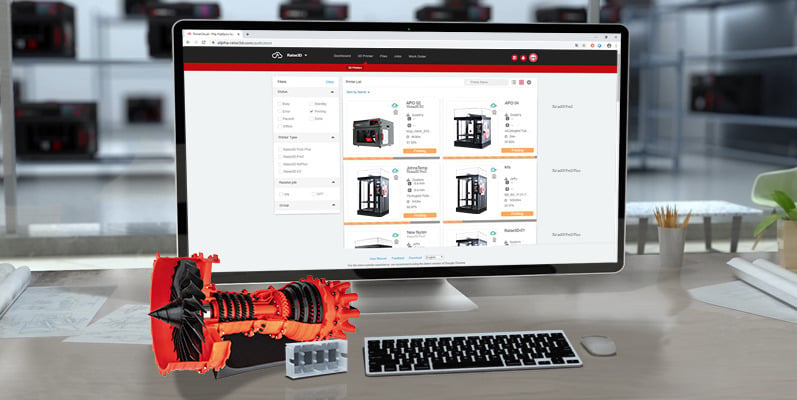
Raise3D not only makes enormous 3D printers, but they’ve also developed their own 3D printer monitoring software. As you might have guessed by the name, RaiseCloud is cloud based, but it’s also available as a mobile app for both iOS and Android.
With its online storage and automation features, RaiseCloud enables you to almost set and forget your 3D printers. This is especially useful when using Raise3D’s larger printers such as the Pro3 Plus, with which large prints may run for days.
With a fully-fledged dashboard with workflow and reporting features, RaiseCloud is well suited to a multi-printer environment. RaiseCloud appears to have been designed with a greater number of users in mind, such as print farms and makerspaces.
Though designed specifically for Raise3D printers, the lite version of RaiseCloud will work with any printer when combined with OctoPrint.
- Best for: Multi-printer environments
- Special features: Custom workflows and reports
- Downsides: Lack of support for non-Raise3D printers unless using OctoPrint
- Price: Free
Repetier

Repetier is a 3D printing software package that includes firmware, a host, and an app to monitor your printer. The server part, which is our focus, provides many of the same features as OctoPrint.
The aptly-named Repetier Server only provides a local network connection, not a cloud service, and it can be installed on a Raspberry Pi or another PC. Control is achieved in two different ways: The first is similar to OctoPrint and uses a browser, while the second is simply through their Repetier Host slicing software.
Repetier has many features and allows you to configure anything from a single printer to a fleet managed by multiple users. However, with so many configuration options, it isn’t as straightforward to set up as others on this list. Repetier provides software for all operating systems and a Raspberry Pi image. This gives you the option to use the same PC for control but still have wireless features.
If this one seems like your cup of tea, know that Repetier offers both a Free and a Pro tier. The Pro version comes with a few extra features, such as firmware uploading and webcam use.
- Best for: Small- or large-scale projects
- Special features: Allows multiple users to print on multiple printers
- Downsides: Tricky setup, no cloud service
- Price: Free for the basic software, one-time fee of ~$70 for the Pro software
SimplyPrint

Next, SimplyPrint isn’t exactly an alternative to OctoPrint, but it’s another terrific web interface that you can use alongside an OctoPrint server. Moreover, SimplyPrint relies on the backbone of OctoPrint to communicate with your printer but offers a much more advanced web interface to make the experience more user-friendly.
Plus, SimplyPrint is cloud integrated, making truly remote, cross-network printer control possible. And you don’t have to worry about printer compatibility, as SimplyPrint works on all the same machines as OctoPrint. But this platform isn’t free and the subscription plans cost from $0 to $35 per month.
SimplyPrint also makes managing multiple 3D printers simultaneously easier than OctoPrint, which is best used with one machine at a time. Additionally, SimplyPrint comes with many features that are only available with OctoPrint as plug-ins. Some of these features include material management for tracking filament usage, automatic printing, SMS notifications, a built-in 3D slicer, and more.
Because SimplyPrint relies on the backbone of OctoPrint, setting this platform up is very similar to setting up an OctoPrint server. You can purchase SimplyPrint’s starter Raspberry Pi 4 kit online, or you can build your own server and download the necessary packages to run the software.
- Best for: Users looking to control multiple 3D printers at once
- Special features: Wide printer compatibility, easy-to-use web interface, cross-network control, support for multiple printers
- Downsides: Somewhat costly (depending on budget and intended use)
- Price: $0-$35
License: The text of "The Best OctoPrint Alternatives in 2024" by All3DP is licensed under a Creative Commons Attribution 4.0 International License.

